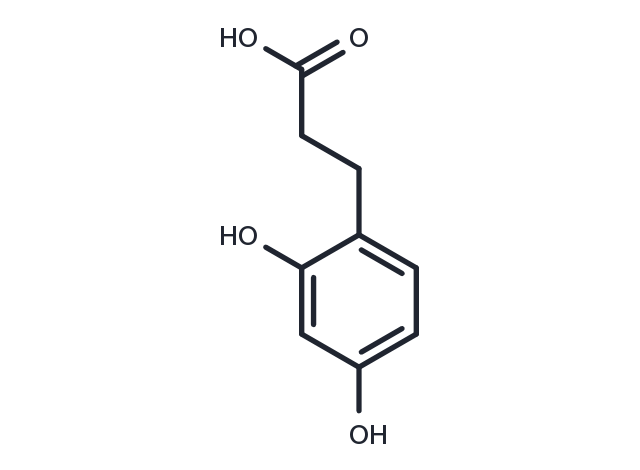Powder: -20°C for 3 years | In solvent: -80°C for 1 year


3-(2,4-Dihydroxyphenyl)propanoic acid (Hydroumbellic acid) is a predicted metabolite generated by BioTransformer1 that is produced by the metabolism of 3-(2, 4-dihydroxyphenyl)prop-2-enoic acid. It is generated by abkar1 enzyme via a reduction-of-alpha-beta-unsaturated-compounds-pattern1 reaction. This reduction-of-alpha-beta-unsaturated-compounds-pattern1 occurs in human gut microbiota.

| Pack Size | Availability | Price/USD | Quantity |
|---|---|---|---|
| 5 mg | In stock | $ 30.00 | |
| 10 mg | In stock | $ 46.00 | |
| 25 mg | In stock | $ 85.00 | |
| 50 mg | In stock | $ 122.00 | |
| 100 mg | In stock | $ 216.00 | |
| 1 mL * 10 mM (in DMSO) | In stock | $ 43.00 |


| Description | 3-(2,4-Dihydroxyphenyl)propanoic acid (Hydroumbellic acid) is a predicted metabolite generated by BioTransformer1 that is produced by the metabolism of 3-(2, 4-dihydroxyphenyl)prop-2-enoic acid. It is generated by abkar1 enzyme via a reduction-of-alpha-beta-unsaturated-compounds-pattern1 reaction. This reduction-of-alpha-beta-unsaturated-compounds-pattern1 occurs in human gut microbiota. |
| Targets&IC50 | DL-DOPA:11.5 μM (Ki), L-Tyrosine:3.02 μM (Ki) |
| Source |
| Synonyms | Hydroumbellic acid, 2,4-Dihydroxyhydrocinnamic acid |
| Molecular Weight | 182.17 |
| Formula | C9H10O4 |
| CAS No. | 5631-68-5 |
Powder: -20°C for 3 years | In solvent: -80°C for 1 year
DMSO: 33 mg/mL(181.1 mM)
You can also refer to dose conversion for different animals. More
bottom
Please see Inhibitor Handling Instructions for more frequently ask questions. Topics include: how to prepare stock solutions, how to store products, and cautions on cell-based assays & animal experiments, etc.
3-(2,4-Dihydroxyphenyl)propanoic acid 5631-68-5 Proteases/Proteasome Tyrosinase inhibit Inhibitor 3 (2,4 Dihydroxyphenyl)propanoic acid 3(2,4Dihydroxyphenyl)propanoic acid Hydroumbellic acid 2,4-Dihydroxyhydrocinnamic acid inhibitor
